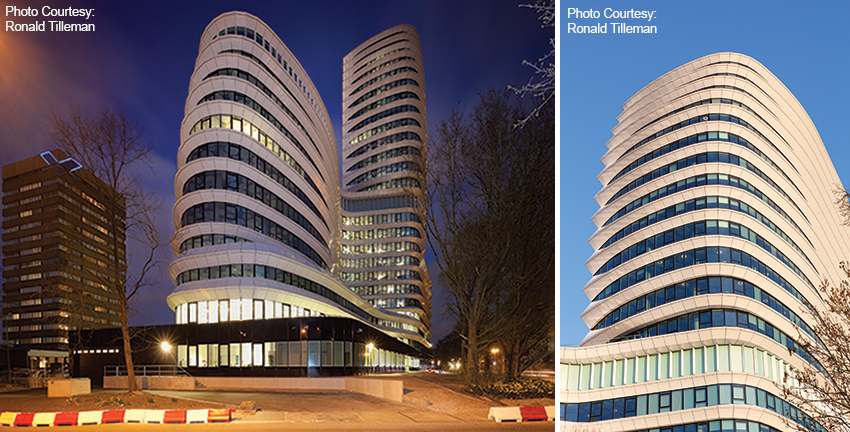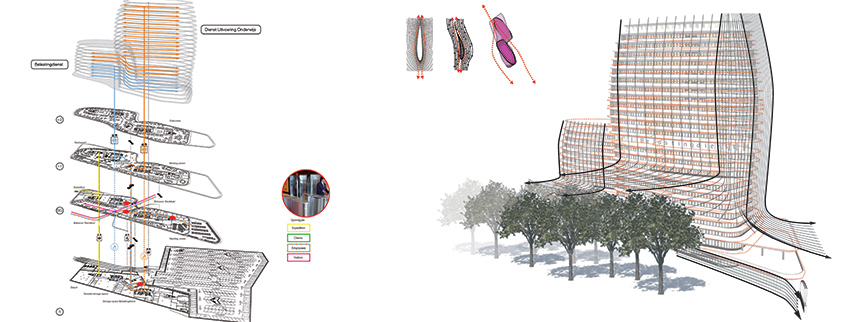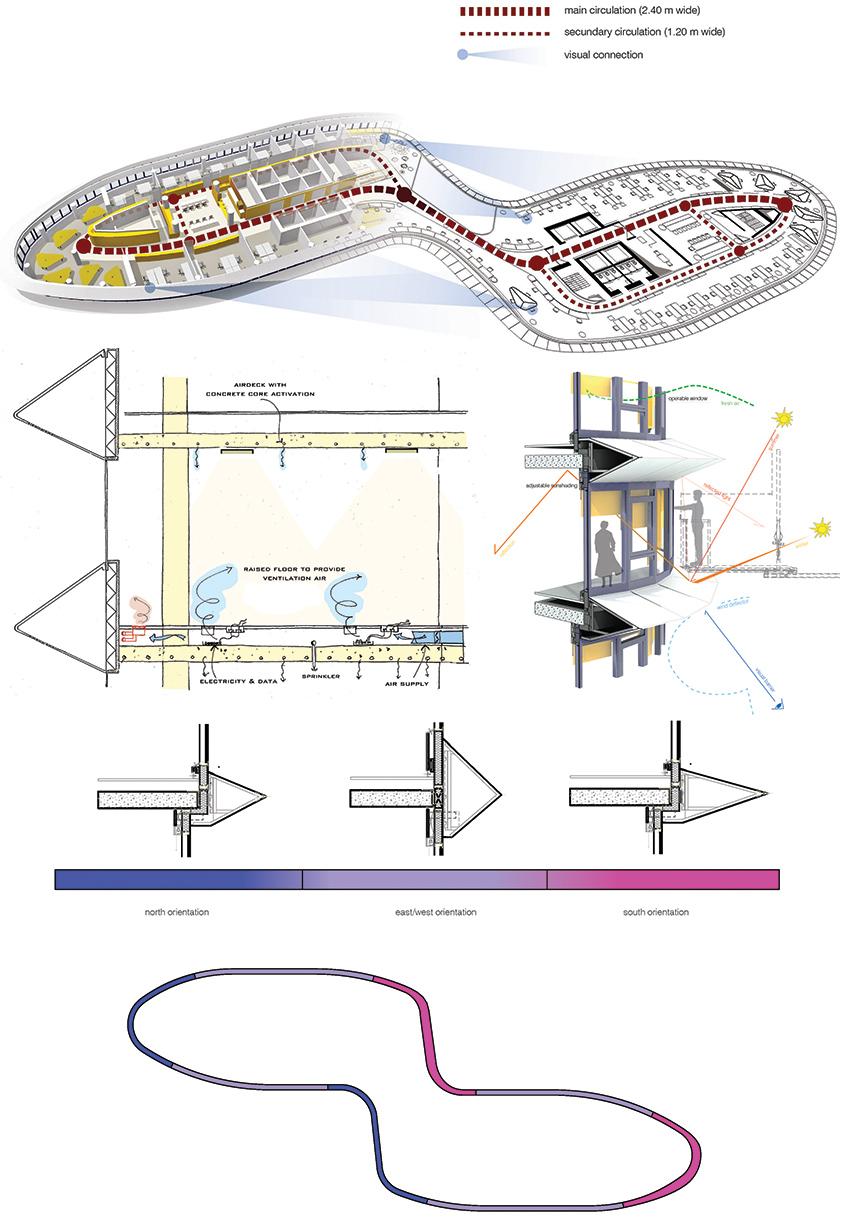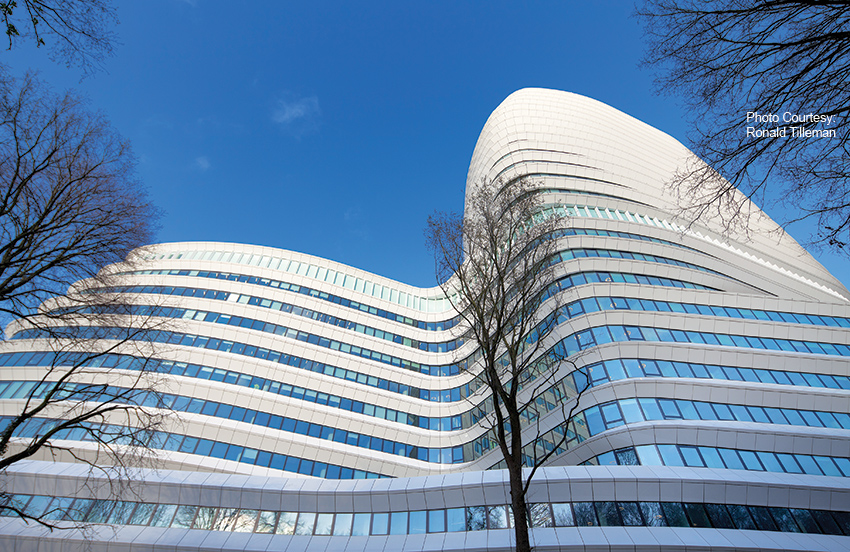


UNStudio/ Ben van Berkel, with consortium DUO², recently completed the swirling and one of the most sustainable large office buildings in Europe for two governmental offices, the national tax offices and the student loan administration. The design for the buildings, accommodating 2,500 employees, reflects and caters to the separate identities of both user groups, whilst simultaneously creating synergy by way of shared use of secondary spaces – among which are underground parking facilities, public gardens, a central hall and a pavilion for commercial functions. The aerodynamic form of the building has been achieved as the result of extensive sun and wind studies. The terraces, rounded corners and façade design guarantee minimum disruption to the microclimate of the surrounding urban green space, known as the 'Sterrenbos', whilst integrating sun shading, wind regulation, daylight penetration and construction in one concept with the result that both material and energy use are minimised.

Tall buildings are generally associated with mid-twentieth century modernism. Their harsh, businesslike exteriors contain powerful, inaccessible-seeming strongholds. By contrast, the DUO and Tax offices deliberately cloak a commanding public institution in an organic, friendly and more future-oriented form.

The architecture of the project was aimed at presenting a design with more human and approachable profile. According to architect Ben Van Berkel, "We paid a great deal of attention as how people would move through the building. The office spaces are designed in such a way that they do not create simple linear corridors leading to dead ends, but instead each corridor has a route which introduces a kind of landscape into the building. One can take endless walks through the building, where there is a great deal of transparency, also towards the surrounding landscape."
Exemplary Sustainability
The new, 92 meter tall complex of soft, undulating curves marks the skyline of Groningen in Netherland. This asymmetric, aerodynamic construction is set amidst small, ancient woodland, sheltering rare and protected species. The design of the project contains numerous new innovations related to the reduction of materials, lower energy costs and more sustainable working environments. It presents a fully integrated, intelligent design approach towards sustainability.The project is one of the Europe's most sustainable large new office buildings. The RGD brief prescribed a future-proof building that couples flexibility and sustainability with an esthetic of sobriety. The architectural response to this, has been to strive for an all-round understanding of the concept of sustainability, including energy and material consumption, as well as social and environmental factors. Thus the sustainability manifests itself in reduced energy consumption (EPC 0.74), as well as significantly reduced material consumption. Bringing back the floor heights from 3.60 m to 3.30 m resulted in a total reduction of 7.5 m on the entire building which also lessens the impact of the building on the surroundings. Both inside and outside the architecture, generates a bio-climate that is beneficial to both humans and the local flora and fauna.
Sustainability and energy reduction have steered the design of the facade which contains technical installations that are tailored to be durable and cause minimal environmental impact. The facade concept integrates shading, wind control, daylight penetration and construction in fin-shaped elements. These horizontal fins keep a large amount of the heat outside the building, reducing the requirement for cooling.
Another technical feature of the building that contributes to its sustainable character is the combination of concrete core activation and underground long-term energy storage. This appreciably reduces the demand for external energy sources.
Creating a healthy, energy efficient interior climate and employee workspace comfort was also an important element in the design. Plenty of natural daylight and adjustable heating, ventilation and access to fresh air for individual workspaces contribute to the comfort of the workspaces throughout in the entire building. A high pressure ventilation system with natural air inflow and outflow via main engineering shafts and the facade grills on the 11th floor also reduces the need for artificial ventilation.
In addition, the residual energy of the data center and offices can be used to heat the homes that will be realized in the future in the perimeter of the site. And last, but not least, the building is designed in such a way that it can be transformed into housing in the future without major structural modifications. Therefore, the locations of elevators, stairs and technical spaces have been carefully considered, and a structural grid of 1.20 m. has been deployed, rather than the conventional office grid of 1.80 m.
The inclusion of diverse passive and active environmental and energy efficient solutions has led to a building which is one of the most sustainable office buildings in Netherlands.
In order to ensure the most cost-effective and environment-friendly complex possible, a public-private partnership (DBFMO) was set up, designed 'to effectuate on a more efficient use of public funds'. As such, a consortium comprising Strukton, Ballast Nedam and John Laing took charge of the design, construction, financing, managing and maintenance of the building. UNStudio, as the architect of the project, collaborated with Lodewijk Baljon for the landscape design, Arup for the engineering and Studio Linse as the interior advisor.















